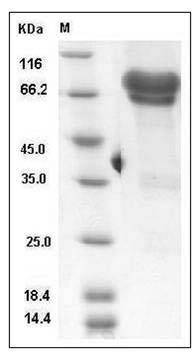-
Product Name
Mouse NGFR/P75 (Fc Tag) recombinant protein
- Documents
-
Description
Low affinity receptor which can bind to NGF, BDNF, NT-3, and NT-4. Can mediate cell survival as well as cell death of neural cells (By similarity). Plays a role in the regulation of the translocation of GLUT4 to the cell surface in adipocytes and skeletal muscle cells in response to insulin, probably by regulating RAB31 activity, and thereby contributes to the regulation of insulin-dependent glucose uptake. Binds to rabies virus glycoprotein Gs. Necessary for the circadian oscilllation of the clock genes ARNTL/BMAL1, PER1, PER2 and NR1D1 in the suprachiasmatic nucleus (SCN) of the brain and in liver and of the genes involved in glucose and lipid metabolism in the liver.
-
Protein name
Tumor necrosis factor receptor superfamily member 16
-
Protein short names
P75NTR; GP80-LNGFR; TNFRSF16; P75; CD271; P75NGFR; RP23-67E18.6; LNGFR; P75(NTR)
-
Uniprot ID
Q9Z0W1
-
Gene Name
Ngfr; Tnfrsf16
-
Source/Expression Host
Human Cells
-
Expression Plasmid/cDNA
A DNA sequence encoding the extracellular domain of mouse NGFR (Q9Z0W1) (Met 1-Asn 243) was fused with the Fc region of human IgG1 at the C-terminus.
-
Protein Species
Mouse
-
Molecular weight
The secreted recombinant mouse NGFR/Fc is a disulfide-linked homodimer. The reduced monomer comprises 463 amino acids and has a calculated molecular mass of 50.6 kDa. The apparent molecular mass of rmNGFR/Fc monomer is approximately 70-80 kDa in SDS-PAGE under reducing conditions due to glycosylation.
-
Purity
> 90 % as determined by SDS-PAGE
-
Activity
Measured by its ability to inhibit NGF dependent proliferation of TF-1 human erythroleukemic cells.
The ED50 for this effect is typically 0.5-3 μg/mL in the presence of 2 ng/mL Recombinant mouse NGF. -
Validations

Mouse NGFR / P75 Protein (Fc Tag) SDS-PAGE
Related Products / Services
Please note: All products are "FOR RESEARCH USE ONLY AND ARE NOT INTENDED FOR DIAGNOSTIC OR THERAPEUTIC USE"
